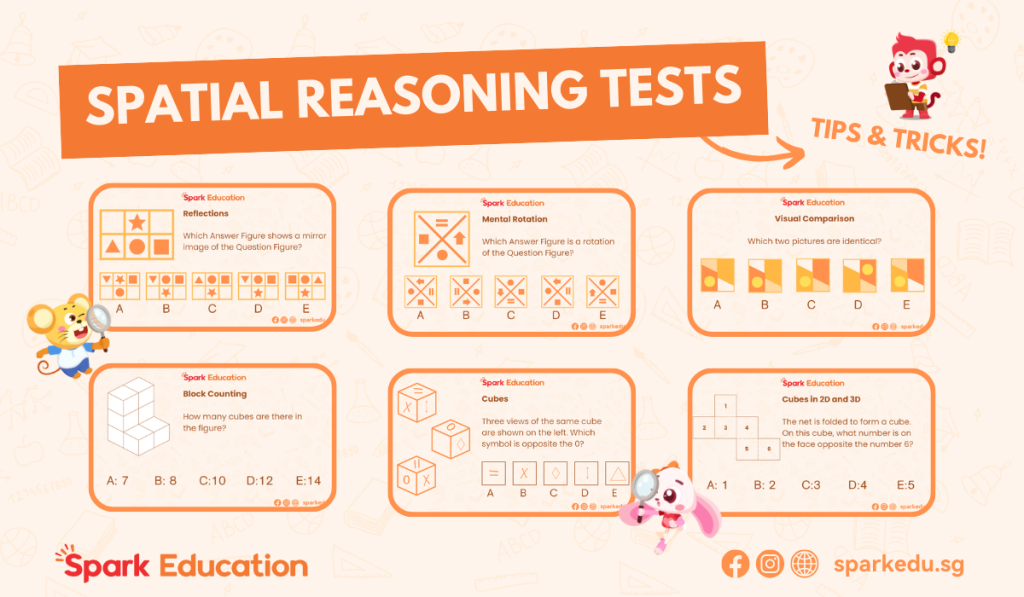
Is your child ready for a spatial reasoning test? This crucial cognitive skill is now essential for entrance assessments in many schools, STEM programs, and gifted education. This guide provides everything you need to understand common test topics and questions your child might encounter. Stay tuned for our next article, where we’ll explore fun activities to enhance your child’s spatial awareness at home!
What is Spatial Reasoning?
Spatial reasoning is also known as visual-spatial intelligence. It includes a basket of concepts, processes, and mental tools, three key skills of which includes:
- Mental visualization: Visualizing 3D objects from 2D pictures or instructions.
- Spatial awareness: Understanding object positions relative to each other.
- Visual thinking: Mentally rotating objects to see them from different angles.
These skills are crucial for kids to visualize, locate, orient, scale, compose, decompose, shift dimension, design, and map with shapes and patterns.
Why is Spatial Reasoning Important?
Spatial reasoning isn’t just about shapes and positions. It is a foundational skill with wide-reaching benefits for young kids.
- STEM subjects: Spatial reasoning is essential for visualizing models, solving geometry problems, interpreting diagrams, and excelling in subjects like science, technology, engineering, and mathematics.
- Problem-solving: Fosters creativity and helps find effective solutions by manipulating mental objects and exploring perspectives.
- Cognitive development: Enhances memory, attention to detail, and critical thinking skills – all pivotal for overall cognitive growth.
- Everyday wins: Makes daily activities easier, from following directions to improving hand-eye coordination in drawing, writing, and using tools.
By nurturing spatial reasoning skills early on, you’re equipping your child with a powerful toolkit for success in academics, problem-solving, and everyday life.
What is a Spatial Reasoning Test?
Spatial reasoning tests assess your ability to understand and manipulate spatial relationships. Visual-spatial intelligence tests can start as early as age 5, and are getting common in both school and and job aptitude assessments.
These tests appear in several contexts:
- Education: Schools and gifted programs, especially in STEM fields, use them to identify strengths and monitor progress. For instance, they are part of entrance exams like the Singapore Gifted Education Program General Ability Paper for Primary 3 students.
- Career: Professions such as aviation, architecture, engineering, design, medicine, and surgery require strong spatial reasoning skills. Schools and employees may use spatial reasoning aptitude tests to assess candidates’ suitability for these roles.
- Cognitive assessment: In psychology and cognitive assessments, spatial reasoning tests gauge individuals’ problem-solving abilities and cognitive potential.
What to Expect in a Spatial Reasoning Test?
There’s no single format for spatial reasoning tests, but they typically involve a variety of tasks that assess different aspects of spatial thinking.
Here are some common question types you can get your child familiar with before these tests:
Reflections
For these questions, you’ll need to identify the mirror image of a given shape or pattern.
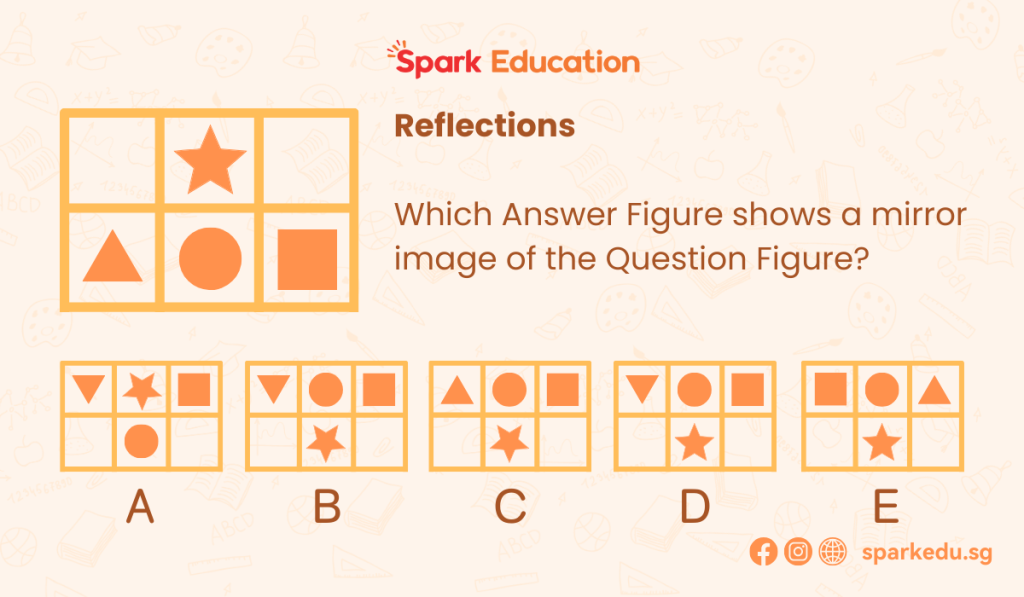
Example question: Which Answer Figure shows a mirror image of the Question Figure?
Solution: Eliminate swapped positions of shapes and elements that aren’t true mirror images. Focus on the overall orientation and details to identify the mirrored version.
- First, check if any shapes have switched positions: Figure A is ruled out because the circle and star have swapped places. Figure E is also eliminated because the triangle and square have swapped places.
2. Next, look for elements that aren’t true mirror images: Figure C might seem correct at first glance, but the triangle isn’t a proper mirror image. Similarly, in Figure D, the star isn’t mirrored correctly.
Therefore, the answer is B.
Answer: B
Mental Rotation
In these questions, you’ll identify which groups of five or six 2D shapes or elements are rotations of each other.
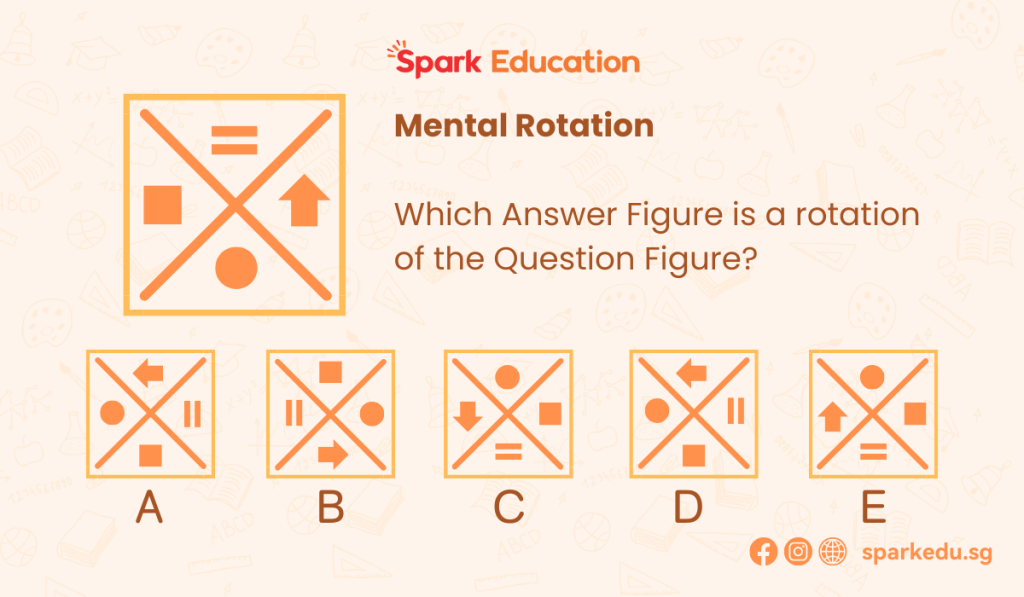
Example Question: Which Answer Figure is a rotation of the Question Figure?
Solution: The most effective strategy is to start with the most asymmetrical shape and identify the positions of other shapes relative to it (clockwise, counter-clockwise, opposite).
- Start with the most asymmetrical shape in the group. In this case, the arrow.
- Next, identify the positions of the shapes. Look for the shapes that are ‘clockwise‘, ‘counter-clockwise‘, and ‘opposite to‘ the arrow.
- Thinking using these terms instead of using words such as ‘right’, ‘left’, ‘above’ or ‘below’ as they remain the same even when the figures are rotated.
- In the Question Figure, the circle is clockwise from the arrow. This rules out Figures A, B and D as rotations of the Question Figure.
- This leaves only C and E as possibilities, which can be quickly checked element by element. Be cautious not to mistake reflections.
- In the Question Figure, the arrowhead points towards the equal sign, ruling out Figure E.
Therefore, only C matches the rotation of the Question Figure.
Answer: C
Tip: You don’t really need mental visualization to solve these questions. Your task is simply to break down the Answer Figure into smaller elements, and then match them with those in the Question Figure.
Visual Comparison
In these questions, you will see several figures, with only two of them being identical.
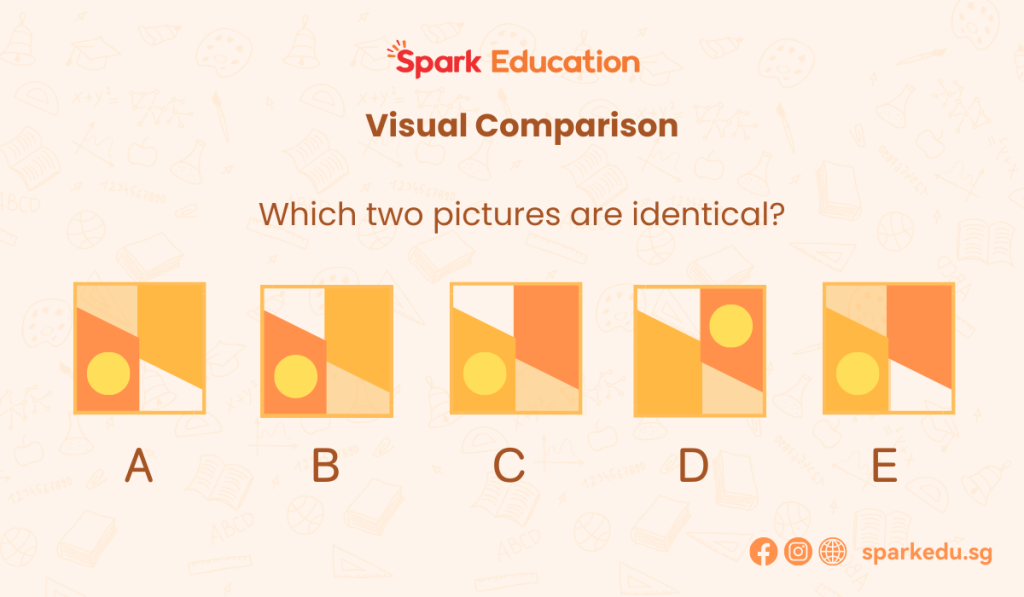
Example question: Which two figures are identical?
Solution: Start with the first figure on the left, comparing it with each figure to its right. Look for an exact match using the skills in Group Rotations. If none matches, move to the next shape and repeat.
Stay focused and stick to the step-by-step approach, even though quickly looking at all shapes might seem faster. Rushing can lead to confusion, requiring you to go back to the methodical way anyway.
Answer: A and D are the only two figures which are identical.
Tip: When there are many similar questions on one page, other shapes can be distracting. Cover them and concentrate only on the two shapes you’re comparing.
Cubes
These questions typically show three views of a 3D cube, each with unique symbols on its faces.
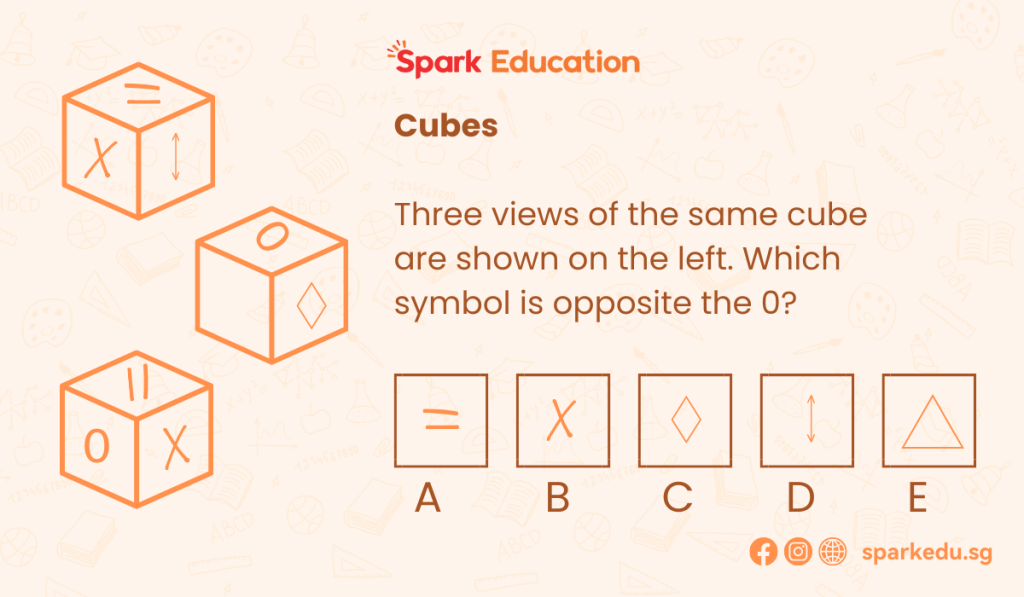
Example question: Three views of the same cube are shown on the left. Which symbol is opposite the ‘0’?
Solution: You can solve this question using spatial or logical reasoning. For those who are good at visualizing objects in 3D mentally, Method 1 may be simpler. However, if mental visualization is challenging, use Method 2.
Method 1: Compare views to identify rotations and opposite faces. For instance, compare the first and third cubes. You will realized that the third cube is a 90-degree clockwise rotation of the first (i.e., viewed from above). Therefore, D is opposite the ‘0’.
Method 2: Eliminate answer choices with symbols visible in the same view as the target symbol. The logic is that the opposite face does not appear on the same view as the target symbol.
First, find the target symbol ‘0’. That’s on the second and third cubes. Then, eliminate symbols visible in the same view as ‘0’. In this case, rule out A, B, C, and E, leaving D as the correct answer.
Answer: D
Tip: Though not always stated, each symbol in these questions is typically used only once. This greatly simplifies the solution process.
Cubes in Two and Three-Dimensions
These questions feature a 2D flat net that folds into a 3D cube, testing your ability to visualize shapes in different dimensions.
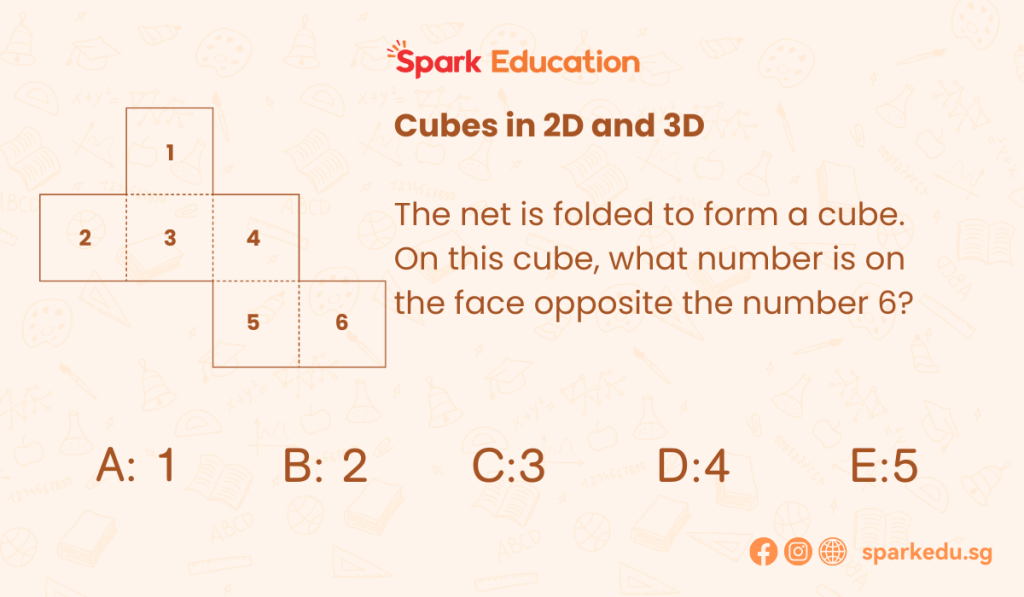
Example question: The net is folded to form a cube. On this cube, what number is on the face opposite the number 6?
Solution: Understand the cube net and locate the square opposite the target square by analyzing which squares don’t touch when folded.
- First, the unfolded net has 6 squares numbered from 1 to 6.
- Locate Square 6, which has three unconnected sides.
- In a cube, opposite faces do not touch. Square 5 touches Square 6 on the left, so Square 5 is not opposite to 6.
- Square 4 is next to Square 5 on the net, placing it adjacent to the top of Square 6 when folded. Therefore, Square 4 is not opposite to 6.
- Square 3 is adjacent to Squares 4 and 5. Since Squares 4 and 5 touch Square 6, Square 3 cannot be adjacent to Square 6. Thus, Square 3 is opposite to 6.
- Verify with Squares 1 and 2. They touch Square 6 when folded.
Answer: 3
Tip: Practice mental visualization, spatial awareness, and object manipulation by cutting a cube into different net shapes. This hands-on approach enhances understanding of spatial reasoning.
Block Counting
These questions feature shapes made from 3D blocks. You have to find out the total number of cubes used while taking into account the hidden ones.
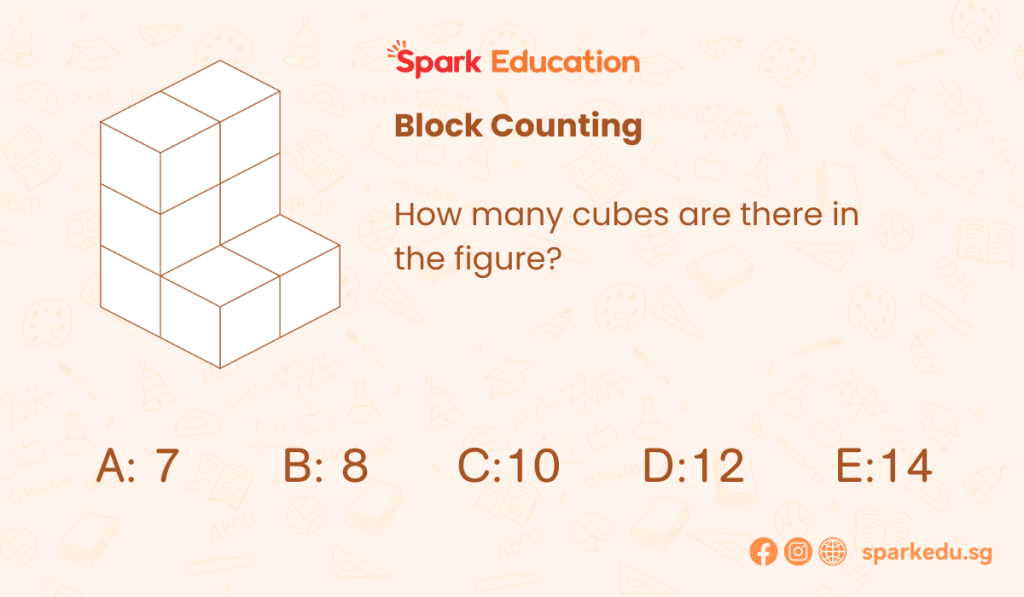
Example question: How many cubes are there in the figure?
Solution: Mentally break up the blocks apart.
Method 1: Divide the block into top, middle, and bottom layers. Then, count the number of cubes in each layer:
- Top: 2 cubes
- Middle: 2 cubes
- Bottom: 4 cubes
Adding them (2 + 2 + 4) gives 8 cubes.
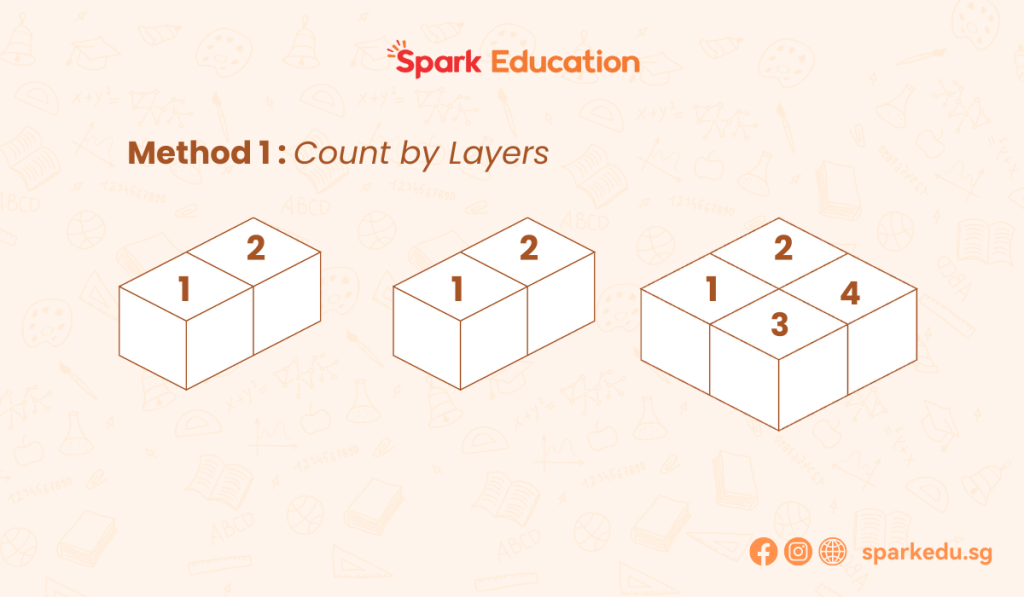
Method 2: Another method is dividing the block into stacks or pillars:
- 2 × 3-cube pillars = 6
- 2 × 1-cbe pillars = 2
Adding them (6 + 2) gives 8 cubes.
Therefore, there are 8 cubes in the block.
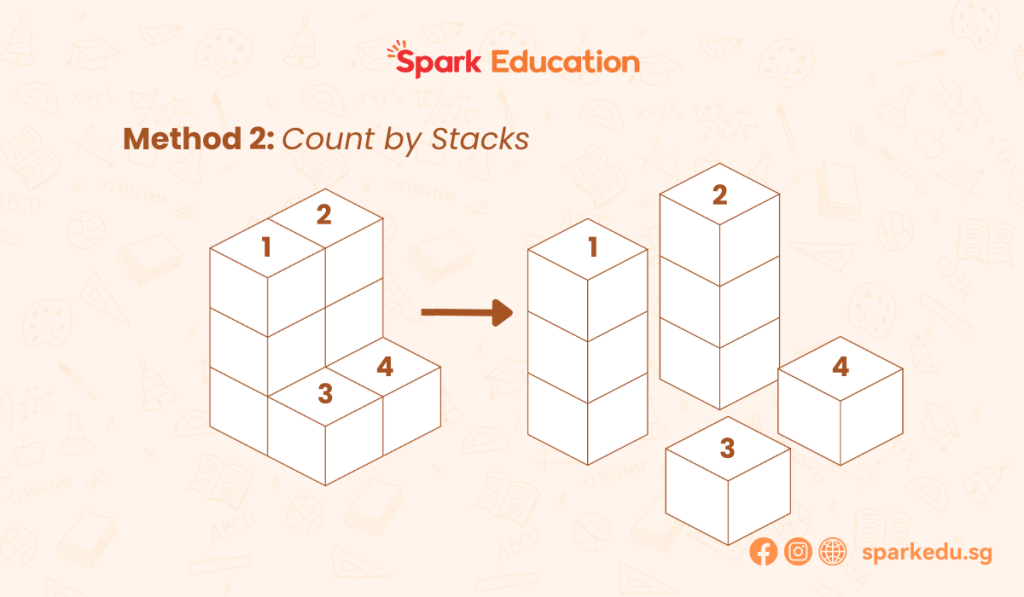
Answer: B
Tip: Sketch the shape on paper and break it down into simpler forms for easier counting.
Tips for Taking a Spatial Reasoning Test
While 2D spatial reasoning questions are generally manageable, time limits can be tough. And, once the questions include 3D object manipulation, many children find it very challenging.
The good news is that spatial reasoning is a skill that improves with practice, especially when started at a young age.
- Practice: Work through practice tests to familiarize yourself with the question types.
- Stay calm: Spatial reasoning tests are often timed, so staying calm under pressure is crucial.
- Read instructions: Understand each question before attempting an answer.
- Don’t guess: Analyze information methodically and eliminate obviously incorrect answers.
- Use visual aids: Sketch diagrams or use scratch paper to visualize the problem — you don’t have to process everything in your mind.
Take time to explore and attempt example questions that assess different aspects of spatial awareness. This helps build the necessary skills before taking a full spatial reasoning test.
FAQs
Spatial Reasoning vs. Logical Reasoning?
Spatial reasoning and logical reasoning are both important cognitive skills. They use similar brainpower (such as working memory and attention) but focus on different things.
- Spatial reasoning: Imagine objects in 3D, seeing how they move and fit together.
- Logical reasoning: Analyze information, find patterns, and solve problems using rules and evidence.
Spatial reasoning can give you a visual framework for a problem, while logical reasoning helps you analyze how to solve it.
Spatial Reasoning vs. Mathematical Thinking?
Spatial reasoning and mathematical thinking complement each other.
- Spatial reasoning: Visualizes spatial relationships and focuses on the “where” and “how” of space.
- Mathematical thinking: Uses logic and symbols to solve problems with numbers, analyzing the areas, directions, distances of space (“what” and “why”).
Strong spatial reasoning can help visualize math problems, and math activities can improve spatial understanding. Nurturing both equips us with powerful tools for learning and critical thinking.
When Do Kids Take Spatial Reasoning Tests?
Spatial reasoning skills develop gradually throughout childhood. The age for these tests can vary, but here’s a general idea of standardized spatial reasoning tests:
- Early Assessments (Ages 5-7): Simple tasks like building blocks or copying patterns.
- Mid-Childhood Tests (Ages 8-11): Mental rotation, form completion, identifying shapes from different orientations.
- Later Childhood and Beyond (Ages 11+): More complex tests like matrix completion, folding/unfolding tasks, and 3D visualization problems.
These are general age ranges. The specific timing of tests can vary depending on the school system and the assessment type.
Conclusion
Spatial reasoning is crucial for children’s development and long-term success in various areas. By understanding spatial reasoning tests and applying the tips provided, you can effectively prepare your child for these assessments.
Remember, the journey of developing spatial reasoning matters as much as the test results. Make learning fun, engaging, and celebrate their growth along the way.
Excited to jumpstart your child’s spatial reasoning? Join our FREE Spark Math trial class today!
Spark Math by Spark Education is an online math enrichment program designed to build children’s math skills in a fun and effective way. Our Advanced Programs cover 100% of the Singapore MOE Math syllabus and adds 20% enrichment, including logical thinking, creative problem-solving, and spatial skills. Explore our Competition Program and Gifted Education bootcamps for advanced challenges.




